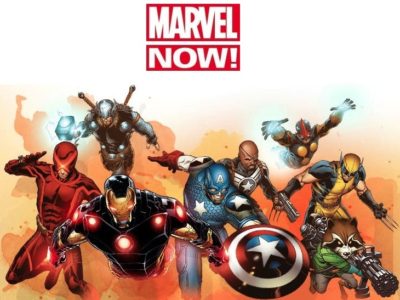 After Avengers vs. X-Men at the end of 2012, Marvel reloaded their entire line save for a handful of just-launched books and dubbed the era of titles “Marvel Now.” There have been a few incremental waves of additional launches since then, but the main spine of Marvel has been telling consistent stories since then – the Avengers and X-Men flagships, their big three Avengers heroes, and Spider-Man.
After Avengers vs. X-Men at the end of 2012, Marvel reloaded their entire line save for a handful of just-launched books and dubbed the era of titles “Marvel Now.” There have been a few incremental waves of additional launches since then, but the main spine of Marvel has been telling consistent stories since then – the Avengers and X-Men flagships, their big three Avengers heroes, and Spider-Man.
The stories haven’t only been consistent – they’ve been really good. Unlike the 2011 DC New 52 launch, Now hit the stands with nothing bad in the bunch. Even as some books declined as the period wore on, we got other amazing winners in the intermediate waves.
Now that we’re only weeks away from the next major period of Marvel where every book will be refreshed, I thought it was the right time to look back about what was so awesome about Marvel Now by ranking every book we got along the way – over 70 ongoing titles!
As with my Writer-Rankings last week, being low on the list doesn’t mean a book was bad – just that it’s not my top pick for you to spend your hard-earned dollars on.
The criteria: I’m a trade-waiter, so books had to release at least one trade by this week. Books from before Now only count if they made it through 2014. No series that were explicitly disclaimed as limited (short series that got cut off by Secret Wars do count). Two volumes of a book by the same author or with continuous story count as one entry – like Daredevil Volume 3 and Volume 4, both by Waid, or Iron Man and Superior Iron Man.
The final trades for these series were too late-breaking for me to evaluate them fairly: All-New Captain America, Amazing Spider-Man Vol. 3, Bucky Barnes: The Winter Soldier, Deathlok, Savage Hulk, Spider-Gwen, Spider-Woman, Unbeatable Squirrel Girl, Uncanny Avengers Vol. 2, Wolverines.
Let’s get to it!
CK Says: Must buy!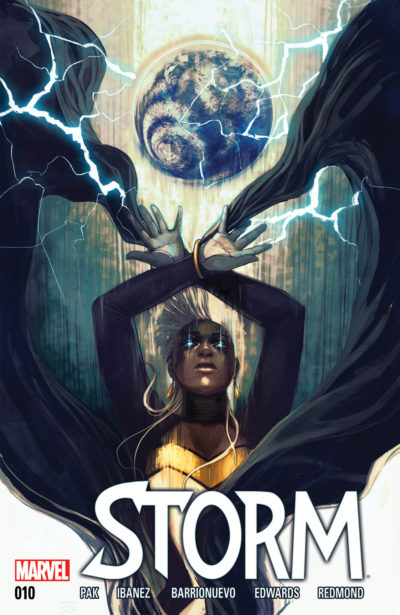
Thor, God of Thunder + Thor by Jason Aaron
The pinnacle of what Marvel Now had to offer in every regard. Writing, character voice, plot, art – all of the above were the best they could be in this landmark run on Thor, which gave way to a historic makeover for one of Marvel’s biggest heroes. It’s like watching Thor as it’s own multi-part cinematic epic with a scope as large as Lord of the Rings. It has my highest recommendation.
Start with Thor, God of Thunder Deluxe Hardcover Vol. 1 or visit the guide.
Silver Surfer by Dan Slott & Mike Allred
Utter perfection in every issue. A wry love-letter to the totally zany Marvel comics of the 60s, where space contained the most improbable things. It was a delight to see Dan Slott step away from his Spidey-mode and push his storytelling to the limits. It makes me wish he had the time and inclination to start up some indie comics, but this is even better – a classic, never-better take on a character who has gone a bit under-appreciated in the past few years. Oh, plus a dozen issue run of Mike Allred’s art? No way to go wrong there.
Start with Silver Surfer, Vol. 1 or visit the Guide to Silver Surfer.
Storm by Greg Pak
Sometimes you see fans ask Marvel editors why a certain character hasn’t yet had their own series, and the reply is usually, “No one’s made the perfect pitch.” Greg Pak had the perfect pitch on Storm. This has everything you could hope for from a series starring the weather goddess and Wakandan ex-royalty, from humanitarian missions to hand-to-hand combat to thievery to clashing with the FBI. Pak executed every moment on this high-wire with precision, and artists Victor Ibanez, Alejandro Barrionuevo, and Neil Edwards gave a real world weight to Ororo’s adventures.
Get it all: Storm Vol. 1 and Vol. 2
Superior Spider-Man by Dan Slott w/Christos Gage
Who knew something so bad would feel so, so good? Spider-Man as a reluctant hero and a recovering villain made for some of the most page-turning issues in his recent history. Even as this All-New Peter Parker reversed his infamous Parker Luck, Dan Slott piled on the misfortune for New York City until the scales tipped and our Superior hero had to make some challenging choices when it came to his newfound success. They say that good stories sometimes put their characters through the worst, and never has that been so enjoyable.
Start with Superior Spider-Man Deluxe Hardcover, Vol. 1 or visit the guide.
Deadpool by Gerry Duggan & Brian Posehn
I am not a Deadpool fan. I AM REALLY NOT A DEADPOOL FAN. This is a character that induced groans from me in every previous iteration, but Duggan and Posehn found a special magic in decrepit old Wade and turned him into one of Marvel’s most-readable heroes – yes, even with the gags intact. It’s hard to believe. Art from Tony Moore, Mike Hawthorn, and Scott Koblish was consistent, flashback issues were a hilarious bit that never got old, and we even found some weighty highs and lows between Deadpool’s marriage, his friendship with Agent Preston, and the reveal of his lost family. If you like even the idea of the Merc With a Mouth with a half-decayed secret heart of gold you must read this run.
Start with Deadpool Deluxe Hardcover, Vol. 1 or visit the guide.
Superior Foes of Spider-Man by Nick Spencer
Nick Spencer crafted a beginning-to-end farcical delight that wound up more of a Rubik’s cube than anyone would have guessed at the start. This sort of clever, indie-style book that elevates minor characters into majors is one of the things Marvel does best in the NOW era, and despite declining sales this book was every bit as clever as the similar tone and look on Hawkeye – and usually a lot more fun to read. Primary penciller Steve Lieber was the only real superhero on the book, delivering classy, pitch-perfect, gag-filled art for the majority of issues. Even fill-ins from James Asmus struck the right tone. A major success.
Get it all in the Superior Foes of Spider-Man Omnibus
Avengers Arena / Avengers Undercover by Dennis Hopeless
We all love seeing teens take up the mantle of our favorite heroes, but seldom do we ask, “What’s the price they pay?” Avengers Academy did a fine job exploring their scarring origin stories and PTSD, but it never touched on the vengeance a true villain could wreak on an impressionable generation of superheroes. Who would have ever thought that villain would be Arcade, the carrot-topped constant failure who habitually plagues the X-Men and Spider-Man for no reason other than his own amusement? Dennis Hopeless drew together dozens of disparate characters and themes to craft a Marvel-style Battle Royale or Hunger Games, yet there were twists within beyond either of those two works. Meanwhile, Kev Walker bloomed before our eyes from the steady-eddie from Thunderbolts to one of Hickman’s headline artists on Avengers! If only Hopeless got another 10 or 20 issues to extend his ideas on Undercover! Yet, even the aborted themes of descent and redemption there were crafted perfectly.
Start with Avengers Arena, Vol. 1 or visit the guide.
Hawkeye by Matt Fraction & David Aja
For all it’s lateness and idiosyncrasies, it’s hard to ignore the heart in Clint Barton as a unloveable screw-up with enough charm to get by and Kate Bishop as an unrepentant A-Student taking a test she can’t study for. Was it worth the wait for every issue? Maybe so, maybe not, but I don’t think anyone wishes that Fraction, Aja, and Wu were pulled off the book at any point to speed things up.
Get it all with Hawkeye by Fraction & Aja Omnibus
Magneto by Cullen Bunn
Here’s the pitch: Magneto, solo (kinda) – but good (kinda), without powers (kinda), and bald (totally) with a serviceable author (Bunn, who has crashed several series to date). Sounds like a surefire miss, right? Instead, it was a glorious, twisted, dark run that breathed life into a Magneto who has been humbled for many years. This run touched many parts of his long and somewhat-mangled history, from surviving the Holocaust in Germany to the genocide of mutants in E for Extinction. I was expecting a X-Men: First Class cash-in, but instead we got some of the best stories every written about this villain.
Start with Magneto, Vol. 1 or visit the guide.
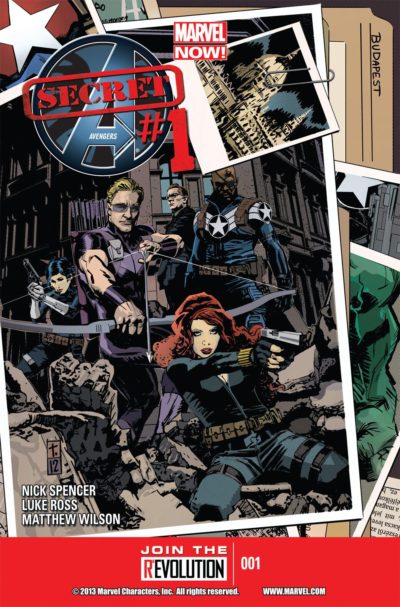 Secret Avengers Vol. 2 + Vol. 3 by Nick Spencer & Ales Kot
Secret Avengers Vol. 2 + Vol. 3 by Nick Spencer & Ales Kot
A messy, messed-up superhero story that didn’t quite require you to read every issue but improved if you did. Spencer and Kot were two of the only authors to innovate on a team book in a period of strong solo work across the Marvel line, and they did it by doing the unconventional – creating a team of heroes that couldn’t remember their deeds, and then augmenting the team with MODOK and a living bomb. Also, Deadpool. It was glorious, and the art – especially by artist Michael Walsh on Kot’s run, had an appropriately slight cartoonish bent (though never so much as the blocky covers).
Start with Secret Avengers, Vol. 1 or visit the guide.
Daredevil Vol. 3 + Vol. 4 by Mark Waid
As nimble as its title character, Daredevil is a title that hops genres and tones and never gets caught off-guard. A slight bobble at the end of each volume is no reason to be down on this all-time classic book, the first one in a long time to put a shine in Murdock’s smile and a devlish glint in his eye. It doesn’t hurt that the artwork was top-notch throughout, with some truly groundbreaking work from Paolo Rivera, Marcos Martin, and Chris Samnee to define the look of the book.
Start with Daredevil by Mark Waid Deluxe Hardcover Vol. 1 or visit the guide.
Loki: Agent of Asgard + Thor & Loki: The Tenth Realm by Al Ewing
Is it blasphemy to love a new Loki other than Kieron Gillen’s? If it is, then Odin is going to strike me down where I stand. Al Ewing’s genre- and gender-bending take on the god of mischief was full of smarts and smirks in every issue, and his artistic collaborators were always on their A-Game. An enjoyable riddle of a book that tapped into Hiddleson’s mischievousness while making Loki more relevant to the onoing story of Asgard than ever.
Start with Loki: Agent of Asgard, Vol. 1
Avengers Assemble by Kelly Sue DeConnick w/Warren Ellis
If Bendis’s multi-year addition to Avengers was giving a soul to a sometimes randomly collected team, DeConnick gave it a heart. There were so many small moments in this run where we saw the human connections that result from battling alongside each other for years. Whether it was the Stark vs. Banner rivalry, the Spider-Woman and Hulk playfulness, the Captains America and Marvel’s exasperation, or Black Widow’s ability to be the subtle social glue to get the best out of a team while never being the obvious “leader.” Every issue and arc here was massively enjoyable, and scratched an itch no other Avengers title has ever before quite hit.
Start with Avengers Assemble: Science Bros or visit the guide.
Angela: Asgard’s Assassin by Kieron Gillen & Marguerite Bennett
Kieron Gillen’s parting love letter to Loki and Asgard comes in this brisk single arc exploring Angela’s first solo adventure as a woman without a realm – not accepted within Asgard, and never truly a winged creature of Heven. What results is nothing you’d expect – an unusual tryst, a touch of darkness, and a best friend who is not all that she seems (nor is that sentence). If you’ve enjoyed any of Thor or Journey Into Mystery in the past few years but wished it had more of a female touch, this is it – especially thanks to awe-inspiring art from master Phil Jimenez and the heavenly Stephanie Hans.
Get it all with Angela: Asgard’s Assassin!
Ms. Marvel by G. Willow Wilson
Ms. Marvel was the major can’t-miss-moment of Marvel Now! It’s rare that Marvel creates a new hero from whole cloth, rarer still for them to debut in their own book, and even more shocking to see that book be given so much room to breathe without crossovers and tie-ins. As we rolled into a second and third set of stories the bigger villain arc got less interesting and the interpersonal relationships got stronger. It will be interesting to see what G. Willow Wilson does with the next volume to set up a nemesis for Kamala.
Start with Ms. Marvel by Wilson Deluxe Hardcover, Vol. 1 or visit the guide.
Elektra by Haden W. Blackman & Mike Del Mundo
Finally, Elektra who is more than just a killer (or just a killer pair of legs and sais)! Blackman’s Elektra was driven by her assassin’s code and a need to be right, and nothing else mattered. While every move seemed to entangle her further in a plot where she had no control, instead of seeing a defeated hero we met one who grew ever more determined. It made for a slick plot and Mike Del Mundo’s art could have been the best interiors of Marvel Now this side of Thor.
Get it all with Elektra Vol. 1 and Vol. 2 and visit the guide for more Elektra.
Keep reading for the books that I recommend and ask you to kindly consider, plus a few I think you ought to avoid.
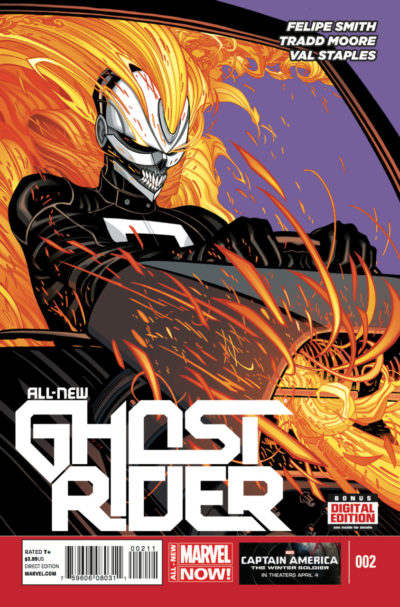 CK Says: Recommended
CK Says: Recommended
Mighty Avengers + Captain America and the Mighty Avengers by Al Ewing
Al Ewing is a Marvel magician, taking a team of barely-Avengers and b-characters from failed mini-series and turning them into one of Marvel’s most delightfully readable books. This series has been well done from top to bottom. Finally, it feels like Luke Cage and Jessica Jones have a home as they mentor younger heroes like the new Power Man and White Tiger. Visit the guide.
Cable & X-Force by Dennis Hopeless
This book was a perfect smash hit that should have turned into a franchise, a point underlined by the assignment of workhorse perfectionist Salvador Larocca on art duties. Cable’s endless cycle of death, time travel, and resurrection is getting more than a little tired at this point, which is what made Dennis Hopeless’s take on it such a delight. This was a dire Cable that was still a riot to read, thanks to pairing his trying to thwart apocalyptic visions with a team of screw-ups and cast-offs left over from the rest of the X-Men draft picks.
So much amazing character work happened here between the missions that it’s hard to choose what to highlight among a long list of strengths: Colossus moving on from Kitty, Forge’s redemption, and Domino and Boom Boom’s BFFs forever. Yet, the real victory here was a focus on Hope as a real, round-character wondering what she is supposed to do with her life after saving the world … really, just save it again? Visit the guide.
All-New Ghost-Rider by Felipe Smith
Ghost Rider as a Latino teen driving a souped-up car with super-deformed, angular artwork? It sounds like a train-wreck, but it was a total hot-rod. Marvel Now really struck the right tone when it came to introducing young, new heroes, and this little-read title was among the best of the bunch. It’s no small feat to make the interpersonal struggle of a family one and the same with the struggle against super-powers. Visit the guide.
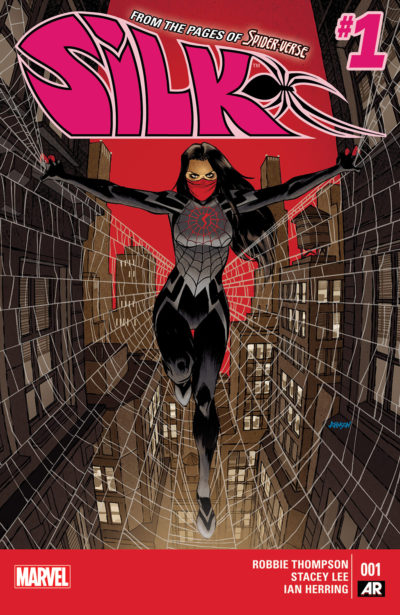 Silk by Robbie Thompson & Stacie Lee
Silk by Robbie Thompson & Stacie Lee
Silk is one of Marvel’s cadre of amazing new legacy characters, but her legacy is a bit different than the rest – she’s been a spider-lady for as long as Peter Parker has been Spider-Man! The catch? Ever since she was bitten by that same radioactive spider she’s been in hiding in an underground bunker to prevent her spider-powers from inciting an inter-dimensional war, and in the meantime her family has completely disappeared.
Now, in the wake of Spider-Verse, she’s out and about after a decade in hiding like The Unbreakable Kimmy Schmidt as a superhero, with all of the pop culture confusion and PTSD that comes with it. This series didn’t get very far before Secret Wars, but everything it achieved was wonderful. Visit the guide.
Journey Into Mystery by Kathryn Immonen & Valerio Schiti
Marvel made a smart move in positioning Journey as an Asgard anthology title that would follow a different hero one volume at a time, but erred in not giving it a true relaunch. Kathryn Immonen did her best Marvel work turning Sif into a motivated character you could root for the first time in at least a decade (maybe since Simonson) and artist Valerio Schiti broke into stardom with searing colors from Jordie Bellaire. Plus: Beta Ray Bill!
How did this mega-hit ever fail? By being one of the only high-numbered books in Marvel Now to continue counting upwards, Marvel might have hoped to draft off of Loki’s Tumblr-loved sleeper run, but no one was fooled. If this had a clean reboot, maybe we’d be getting an amazing Fandral solo series right now. A boy can dream, can’t he?
Spider-Man & The X-Men by Elliott Kalan
This book was destined to be a throw-away, just one more volume to fill in the Wolverine void for a year before the big reset button got pressed. Instead we got one of the most amazing Spider-Man books in years – one where he never takes off his mask, has a romantic interest, or falls prey to his rogue’s gallery. Oh, and it was also the best younger X-Men book since Kyle and Yost on New X-Men a freaking decade ago, both breathing life into two of their favorites in Hellion and Rockslide and making Aaron’s freshly-made Shark Girl into a real star.
Spider-Man hasn’t done this funny all-ages feel in-continuity for a long time, and this could be the best use of him as a mentor… maybe ever? A hidden gem in Marvel now. Maybe only a throw-away could have been this good. Visit the guide.
Avengers World
Here’s the secret heart of the Hickman-era Avengers: This is the title where we see what the core team is doing while they aren’t worrying about Incursions and battling Builders. Their trio of challenges – a city of the dead, a city that’s a dragon, and an impenetrable sovereign island – were each more interesting than what was going on in the main Avengers book and made the outsized Avengers team of 18 members seem both necessary and exciting. Also, artists like Stefano Caselli, Rags Morale, and Marco Checchetto didn’t hurt – they’re some of the best in Marvel’s stable. Visit the guide.
Iron Man + Superior Iron Man by Kieron Gillen & Tom Taylor
The thesis statement of Marvel Now was “musical chairs” – rotating the creators who had hit their stride onto unfamiliar books. X-Men’s major loss was Iron Man’s great gain, as Kieron Gillen took Tony through a series of shorter stories that helped align him more with RDJ’s globetrotting movie version, and then into space to hew closer to Tony’s heart than the title has ever gotten (shrapnel aside). A late-stage revamp of Mandarin’s rings wasn’t up to par, but the subsequent relaunch of an Iron Man flipped over his Axis by Tom Taylor was a surefire win. Taylor showed just how dangerous and selfish Tony Stark could really be if his heart was in the wrong place, but also how much more of a success he could be if he ditched his altruism entirely. I think this run will stand up just fine in hindsight against Fraction’s celebrated preceding work. Visit the guide.
Young Avengers by Kieron Gillen & Jamie McKelvie
The final trade of this Gillen/McKelvie jam was titled “Mic Drop At The End of the Universe,” and that’s a fine statement for this series as a whole. Kieron Gillen took a youthful Avengers team that was as much superheroes as they were the O.C. (they were created by O.C. writer Allan Heinberg) and just dove deeper by focusing MORE on relationship and MORE on feeling stuck under a generation that just won’t make room for your success.
This book made an undeniable star out of Miss America Chavez, took Prodigy from discarded X-Men to relevant character, and did something new and a little uncomfortable with gay teen heartthrobs Wiccan and Hulking. And, eh, maybe you won’t like the central parents as an evil undifferentiated mass plot, but if you don’t maybe you just forget what that felt like? How’s that for a mic drop? Visit the guide.
S.H.I.E.L.D. by Mark Waid
Phil Coulson is the new Nick Fury, and this is the modern day version of Agents of SHIELD that have a lot more to do with their super-powered sometimes-partners than ever before thanks to the synergy of Marvel’s cinematic universe. That could have yielded a snoozy anthology, but instead it turned into a savvy mash-up that paired the kick-assery and science of SHIELD with the uncontrollable magic of Dr. Strange and Scarlet Witch before they each had a shot at a solo title. It’s doubly enjoyable if you know the SHIELD team from TV, but even if you don’t it’s a fun little book.
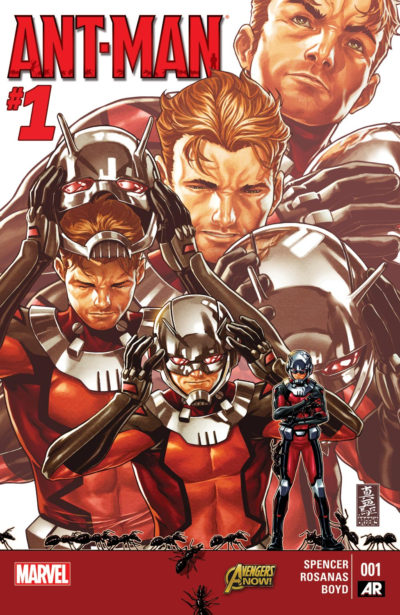 Avengers & New Avengers by Jonathan Hickman
Avengers & New Avengers by Jonathan Hickman
Hickman’s intertwined flagship titles grew around each other like a pair of vines until by the end of the run the divide between them were indistinguishable. This is a run that will read better in retrospect, as you can quickly surge through all of Hickman’s mythology and carefully laid connections. It took the Time Runs Out leap ahead to escalate this to the amazing territory it touched up front, but the payoff never felt worthy of the lead-up. Still, in one lump sum it may seem more fantastic and less of a fizzle. Visit the guide.
Ant-Man by Nick Spencer
The second of three Ant-Men gets divorced from New York superhero hijinks and moves to Florida. Why are we reading this again? Because Nick Spencer hit his full stride with weirdo, outsider anti-heroes with Superior Foes of Spider-Man and this book was a more focused, less serialized shot at the same vibe. Despite a few regressive elements (daughter Cassie gives no hints of being a formal full-time Avenger), on the whole this book is very satisfying if you’re okay with a (PUN) smaller scope.
She-Hulk by Charles Soule
Charles Soule took one of the strongest woman in the Marvel Universe and made her physical strength an afterthought. She-Hulk was about Jennifer Walters strength of will and of purpose, and how she’s driven equally by doing things right and the need to occasionally SMASH. A pair of issues with hideous art is really the only drawback to this very enjoyable run mostly illustrated with a decidedly 60s flair by Javier Pullido. Visit the guide.
Cyclops by Greg Rucka and John Layman
Rucka and Layman unbelievably uncovered some real truths about father/son relationships while focusing on the squarest of all the original X-Men. They did it in the most unconventional way: by going full-on Peter Pan on this youthful Cyclops and giving him a pirate’s life alongside dad Corsair. Whether it was being abandoned on a desert planet or conniving against a ship full of rival pirates, this Cyclops felt real and really like the boy of the man we’d come to read for decades if only he had a real father figure and not the distant and bitter Professor X.
Corsair and Xavier both have constantly-failing moral compasses, but boy do they yield different results! Add to that beautiful artwork from Russell Dauterman (drafted for Thor) and Javier Garron and this book was a secret hit that I’ll treasure for years to come.
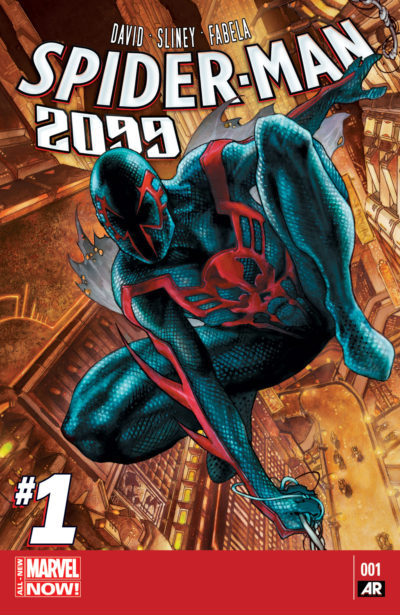 CK Says: Consider it.
CK Says: Consider it.
Fantastic Four, Vol. 5 by James Robinson
What’s the best solution for a comic coming off of an all-time acclaimed run followed by a major mess? All fan-service, all the time? You could call this James Robinson and Leonard Kirk run that, but you’d be mistaken. Yes, this was full of nods to tons of FF stories both new and old and their unexplored ramifications. More than that, it was an example of how easily non-super forces could dissect a team whose only mandate was to be a family. This story could never be shifted to the Avengers or recycled for the X-Men, and even though it wasn’t a major hit you will appreciate how very Fantastic it is. Kirk is a massive part of that, a secret weapon who makes heroes animated and distinct in a way that Mark Bagley perfected over a decade ago. Visit the guide.
Spider-Man 2099 by Peter David and Will Sliney
We’re back to the future and it feels so very good. Peter David returned to the original 2099 creation after nearly 20 years away with a sense of verve and wonder than writers born in that period should aspire to. Yet, David wasn’t working alone here – Irish artist Will Sliney came into his own after his run on Fearless Defenders and put the zing in Spider-Man’s swing. That made for a very readable run that was beautifully unmoored from complicated continuity. You didn’t need to read the original or the contemporaneous Spider-Man to enjoy it, even during Spider-Verse. I’m ecstatic to see this book made the cut for further adventures in All-New, All-Different Marvel.
New Warriors by Christopher Yost
Christoper Yost can make magic with any book. Case and point: a New Warriors reboot that literally no one was asking for, which made you realize, “Yes, Justice and Speedball really were the heart of that team and that happened for 75 whole issues.” Despite a serious de-aging of both of them, somehow this book really stuck. Maybe it’s because Marvel hasn’t done a standalone young-heroes book other than Runaways for a long while. Maybe it was because some of these characters were such blank slates that any story could fit them.
Actually, it’s because Yost is a serious all-pro and he figured out that to make a good New Warriors book you don’t need to make a lot of nods to specific history (because there really aren’t that many fans who will flock back for that), you just need to have them fight the good fight. The first trade of this book was perfect comic writing and perfect art from DC defector Marcus To … really, just perfect. Visit the guide.
Red She-Hulk by Jeff Parker
This wonderful and completely-ignored title tells us some truths about modern-day Marvel. Fans claim they love soaked-in-continuity big stories, but if you put a minor character in the middle of one that’s just as well-baked as the big story in Avengers, she still gets ignored. Jeff Parker seriously did every single thing right in playing Betty Ross as both a super-fugitive and also an unlikely defender of time and space. This was a story that really could have gone somewhere, but that doesn’t mean you can’t enjoy the two volumes we got. Visit the guide.
Savage Wolverine
An anthology series of Wolverine stories so far-flung that they’re out of continuity for all intents and purposes. No thanks, right? Well… read the stories first. After two longer arcs to introduce things (a popcorn beat-em-up from Frank Cho and a previously shelved Elektra/Hand story from Wells and Joe Mad), the creators got more diverse and the stories more compelling. Wolverine alone on an alien planet. Wolverine as a bootlegger. Wolverine protecting African Elephants from poachers.
As the stories got less and less super-heroic and more human the book got more and more fascinating until it was must-read territory for me. That’s not going to be true for everyone, but the creator-centric vibe of this volume means there’s really no weak point – just stories you might not like. Visit the guide.
Nova
What should have been an easy-to-cancel, tossaway book that stumbled through a trio of authors became inbued with a surprising amount of heart. Loeb, Wells, and Duggan crafted a memorable new Nova who wasn’t reluctant to take up his mantle so much as puzzled that being a hero didn’t fix all of his family’s problems. It was much lighter on self-discovery than Ms. Marvel, but included tons of kick-ass space battles to make up for it. In that way, this pair of teen legacy-hero titles were like two sides of a coin minted by Lee’s original run on Spider-Man. If Nova happened to get a bit snoozy during Axis, we can forgive it for sticking to its guns as a fun kid-friendly book that didn’t need to get all tied up in saving the universe to be worth reading. Visit the guide.
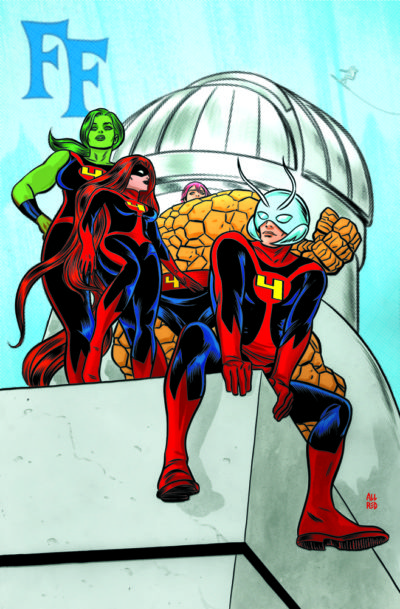 Captain Marvel Vol. 7 and Vol. 8 by Kelly Sue DeConnick w/Warren Ellis
Captain Marvel Vol. 7 and Vol. 8 by Kelly Sue DeConnick w/Warren Ellis
I love Carol Danvers and I love Kelly Sue DeConnick, so what is this book doing hovering in the middle of the list? Despite each individual adventure being greatly satisfying, these volumes never found a greater purpose for Carol. The distinct feeling was that she was being plugged into a series of stories that could work for any other character just to see how she would react, even when they purported to be rooted in her own history. Maybe that was the point – to humanize her and show she could be a captain, a rebel, and a friend all at once. Still, after 100 issues going solo, it still doesn’t feel like we’ve been told a perfect Captain Marvel story. (Also, totally mismatched art from Felipe Andrade didn’t help at all). Visit the guide.
FF, Vol. 2 by Matt Fraction & Lee Allred
This was the little title that could until it didn’t. Matt Fraction’s heart was clearly with the hodgepodge of super kids left under the Fantastic Four’s tutelage, and the best thing he could do after Hickman’s greatest-of-all-time run was to take the actual Four out of the equation and fill the power vacuum with a seemingly random dice roll’s worth of characters from the FF allies gallery – Medusa, Ant-Man, She-Hulk, and a random pop-star dressed up like the Thing. The result was something so good and so perfect that the issues seemed to unfold before you and read themselves.
Fraction is destined to write this sort of heart-warming family affair, but instead he whisked off to write about sex and mythology. That meant we got a slightly dodgy finish, not through any fault of Lee Allred, but because this book ultimate did need to tie in to Fraction’s main-foursome romp, and that bit wasn’t very interesting or coherent. That just means we have to clutch those early issues even closer to our chests and never let anyone take them away. Visit the guide.
Fearless Defenders by Cullen Bunn & Will Sliney
What’s the matter with some pulpy fun? While Fearless Defenders wasn’t the best cutting-edge, modern Marvel book, it would have been a killer comic in the late 80s – that is, if they made all-female comic teams back then. That’s the feel this Cullen Bunn / Will Sliney jam had thanks to its rapidly-moving plot, random guest appearances, and massive team-size. Bunn had a great idea here, and it was just too off-kilter for much of an audience to show up. Visit the guide.
Indestructible Hulk + Hulk by Mark Waid and Gerry Duggan
What would happen if a super-famous writer built an all-new, all different version of a major Marvel mainstay and no-one cared? Mark Waid did just that with his initial Hulk run, which saw Banner using Hulk as a gamma-sized weapon when his science-y missions went to hell. It was a great, inventive take on Hulk, but when it didn’t catch fire Waid lobotomized his compelling leading man and then hit the eject button. Then, Marvel’s newest rising star Duggan took over and did just fine by writing an encyclopedia of all things gamma-radiated, with Hulk starring as both the hero and villain. If you dig Hulk but don’t always want the smashing that comes with him, this is the run for you. Visit the guide.
All-New Invaders by James Robinson
A pensive, heavy-hitting take on the ramifications of applying no-holds-barred superheroics to a time of war. First we get the interplanetary version, and then a look at the impact much closer to home. James Robinson is brilliant on reviving these ancient themes, and the book was gorgeous due to Steve Pugh’s grounded pencils. Its only crime is that it could move a bit slowly. Visit the guide.
Punisher by Nathan Edmondson
Frank Castle isn’t an undefeatable strategist, but a man who gets up again every time he’s knocked down. Can the hyper-violent Rambo of Marvel’s universe go toe-to-toe with super-powered characters and still feel relevant? This title says yes, dropping a Spidey-villain and a mutant into arc one, plus an undercurrent of privatized black-ops. It’s a much subtler take on Punisher, and it was an enjoyable read. Visit the guide.
Inhuman by Charles Soule
What do you do when one of your major architects writes a story-bible that’s Game of Thrones in scope for the new franchise you’re pushing the hardest and then walks off the field? Sub in the guy who can seemingly write more scripts in one month than any other writer in comics and tell him to run the ball. Charles Soule did just that, pounding out more plot ideas in 15 issues than most decompressed titles might see in a decade. From royal intrigue to tough new teen heroes to buddy cops to those warring Throne-ish families, Inhumans was a jack of all trades and master of none. That’s fine – the track had been laid for him to make major moves in All-New, All-Different Marvel, and you’re going to want to study this primer carefully while he keeps running. Visit the guide.
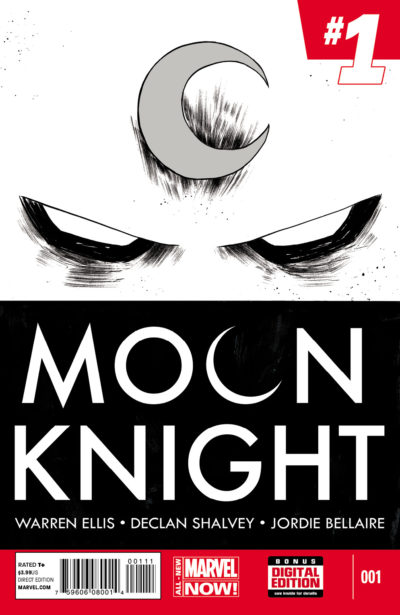 Moon Knight by Warren Ellis, Brian Wood, and Cullen Bunn
Moon Knight by Warren Ellis, Brian Wood, and Cullen Bunn
Moon Knight was riding an amazing high before Bendis muddled it up in a supposed star-making series that turned out to be a flop. Enter master deconstructionist Warren Ellis, who took Moon Knight back to basics in a series of one-shots with him battling supernatural threats. It was a great nod to his roots, but even after Wood and Bunn laid their hands on the title this felt like a faint echo of the meaty mid-00s run by Huston. It was enjoyable stuff that fans ate up and it makes for a great read. I was just hoping for more. Visit the guide.
Legendary Star-Lord by Sam Humphries
In comics, Star-Lord can be a bit of a cypher for writers to project their needs onto – how else to explain his rational turn as a general in the Annihilation sequence followed by a return to space-piracy under Bendis to make way for a movie incarnation. Writer Sam Humphries leans hard into giving that carefree pirate some motivation as well as a focus on someone other than himself with an improbable Kitty Pryde romance. It wasn’t the best book on the stands, but it looked marvelous and put a smile on my face. Visit the guide.
All-New X-Factor by Peter David
Peter David may be the only man who will ever pen X-Factor at this point, and it’s for good reason: no one else in the Marvel stable does super-team as regular people as well as him. His concept this time around – X-Factor as a corporate PR team – had a lot of legs and yielded a series of good stories. However, it was slightly hamstrung by a bad draft of characters. David has succeeded twice in the past with a team of tossaways, but the snoozy threesome of Doug Ramsey, Warlock, and Danger without Emma to play off of dragged down the inventive fun he was having with Polaris, Quicksilver, and a quite-delightful Gambit. Despite enjoyable art from Carmine Di Giandomenico, the colors from Lee Loughridge were a rare miss: they trended a queasy-making orange and purple. Visit the guide.
Black Widow by Nathan Edmonson & Phil Noto
Natasha’s most-successful solo break-out is all about the vulnerabilities beneath the cold warrior. At times she comes off a little too weak as she runs like a rat in a maze, getting battered and making wrong decisions left and right. Do all female heroes have to be so darn fallible? On the flip, maybe the thing that made Black Widow so uninteresting before was her perfection. Either way, the result is the polar opposite of a male-gaze invincible action toy – in no small part thanks to peerless art by Phil Noto. Visit the guide.
Uncanny X-Men by Brian Michael Bendis
You have to take your X-fan hat off to appreciate this book. Yes, it’s glib disregard of continuity and character voices is about as terroristic as its stars Cyclops and Magneto. Yet, the new mutants are distinct and funny, the plot moves, and the moral grey of Cyclops gets deeper and deeper. Plus, Chris Bachalo is at his best in years of illustrating the X-Men, and guest artists like Irving Frazier and Andrea Sorrentino rocked. Even with a dull detour to Xavier’s last will and testament, this book managed a few interesting ideas – and it hasn’t quite shuffled off the stage just yet, since the last issue isn’t due until December! Visit the guide.
Amazing X-Men
A clever take on the X-Men that feels suited to former fans of the cartoon is never a bad thing. Maybe that’s because this book wasn’t shy about leaning on classic threesome Storm, Nightcrawler, and Colossus plus Iceman, and in that context the addition of Northstar and Firestar felt just fine. This one was fun to read and had great, glossy art throughout three big stories about Nightcrawler, Wendigos, and Juggernaut – with several fine filler issues between them (#13, especially). It wasn’t groundbreaking, but it was one of the few truly joyful X-Men books in this era – that counts for a lot. Visit the guide.
Superior Spider-Man Team-Up
Dan Slott was so busy putting Spider-Ock through his paces against the Green Goblin in the main spider-book that he didn’t get to stop to explore too many delicious interactions with other heroes or former villainous teammates. Team-Up did just that, although it meant de-railing a fine story that had been developing across the disparate team-ups in the prior volume. There was no revelatory finish to this series, but it was still a series of damn fine Spider-Man stories with a twist. Visit the guide.
A+X
This mashup anthology was never bad and I found myself missing it once it was gone. Its sin was its strength: being so very continuity free – enough that it joked about it at the top of every issue! That made for some great stories, but at a point when Marvel on the whole hardly cares about the sequencing of its stories this book could have had a bit more heft with more rooted-in-time A-stories like the Cyclops and Captain America tale that closed it out (even if that was possibly the worst tale in its line-up). Visit the guide.
CK Says: Not Recommended
Guardians of the Galaxy
Pure, schlocky popcorn fun. That’s it, really. There was a bit of a central plot of Star-Lord flouting his father’s will, but this book was all about being gorgeous and easy-to-read without having to think too much. That was emphasized by a run of oddly out-of-place guest-members – Iron Man, Angela, a weirdly under-used Captain Marvel, and an almost-fitting-in Agent Venom. Fans of the movie are advised to go for the Lanning and Abnett ultimate collections, Volumes 1 and 2. Visit the guide.
Rocket Raccoon by Scottie Young
[Revised 9/23] It’s a hyper-violent, sentient, smack-talking non-raccoon wielding weapons of mass destruction in space – what’s not to love about this much-fuzzier Deadpool? Most people would say: nothing. For me: this was lightweight but not quite kid-friendly, which made its place in the world a little hard to understand. I didn’t see how a slight theme of chauvinism in the first volume was necessary – not from the character necessarily, but from the framing. Sorry, I can’t help it: I’m a Social Justice Bard. The book corrects its course a bit in the back half, but really only delivers one great story along the way. This should have been an awesome, kid-friendly-er, parents-approved sort of book with some questionable language. Instead, it was just another annoying comic for big little boys. Visit the guide.
Avengers A.I. by Sam Humphries
What a weird book. Should it have been called Avengers? It’s hard to say. Really the only Avengers-ish part of it was a central Hank Pym and Vision, but the focus was really on a fully-formed AI world and the ethics therein. Despite a few action beats and bringing in the Uncanny team to liven things up, this was its own crystalline success if you have the patience for its plot and don’t expect a big blow-out. Visit the guide.
X-Force by Simon Spurrier
Simon Spurrier inherited a merged X-Force team that was a killer’s row – Cable, Psylocke, Fantomex, Marrow, Domino, and Dr. Nemesis as the science guy. His concept was amazing – an all-seeing supervillain using rapid evolution as his weapon and painting a target on mutants. What we got was a lot of talk – it’s Spurrier’s speciality, but it never felt right on this team of typically stoic warriors. The voices were always off. When we finally were embedded with some armed forces for a few issues with X-Force as the grim background villains the book was at its best. Visit the guide.
Nightcrawler by Chris Claremont
Chris Claremont turned in a take on Nightcrawler that is both fun and a bit overly-wordy. It’s hard not to pine for what this could have been as X-Men Legacy, with Claremont free to widen the focus a bit, but Nightcrawler solo efforts are never a waste of time. There was swashbuckling, sudden romance, psychic-powered badass women who still need saving, and adorable miscreant kids. It’s everything you want from Claremont!
Morbius: The Living Vampire by Joe Keatinge
Joe Keating tried to write a friendly-neighborhood vampire with mixed results. The story felt like the right scope and the art from Richard Elson was animated perfection. In some other reality this became the smash that Hawkeye was. However, in our reality it was simply a bit slow, and lacking the hook to make readers rabid.
Captain America by Rick Remender
Prior to Marvel Now, I was the one saying, “Just give it all to Rick Remender!” Now, I understand the idea of too much of a good thing. His deconstructionist urges on Punisher and Uncanny X-Force proved an inconsistent fit on a should-be classic like Captain America. His alternate-dimension take on aging Steve Rogers and giving him a found family felt wrong – it had been done before with Hulk (although, the addition of Ian to Cap’s supporting cast was a good one). A weirdly mushy arc followed, which in retrospect was more about positioning Falcon than addressing Rogers. Next time, Remender should jump right in with the new concept rather than disassembling the old one for months – it was boring, and he ran out of gas as a result. Visit the guide.
All-New X-Men by Brian Michael Bendis
Forty issues later and the one interesting thing that happened in this book is still the first issue when the team of original X-Men travelled from the past to the present. That’s a problem – why buy the other 40 issues?! Well, they did look amazing, that’s for sure. Bendis thrust the time-traveling X-Men into any situation where he could write 20 pages of dialog. A few beats were fun, like this young team of X-Men against The Purifiers and Jean training with Emma, but nothing memorable happened except for the poorly executed uncloseting of a particular original X-Men. Visit the guide.
Uncanny Avengers, Vol. 1 + Axis by Rick Remender
Marvel’s mightiest and most uncanny teams combined should be the comic equivalent of a blockbuster summer movie – especially with the best-of-the-best of Marvel artists like John Cassaday, Daniel Arcuna, and the incredible Steve McNiven. It wasn’t, and I’m still not sure why. Things started out massive and dauntingly difficult for our heroes. When things were at their worst, heroes were dropping left and right! When it became apparent this was just a feint towards a non-counting alternate reality plot, things got very tedious. Like, “Man, I can’t wait for this to be over” tedious.
Finally escaping that, the first arc finally resolved with the overblown Axis. It never really paid off the heartstopping reveal of Red Skull and Onslaught from the beginning of the book. Unfortunately, Remender was battling his own expectations. It would be incredibly difficult to top Uncanny X-Force, which had similar themes and was one of the best comics of the last decade. If this was actually just the back half of that volume with those characters and their accumulated history, it would have been more interesting. It never really felt right as its own title where none of the big-name heroes under Remender’s pen was really allowed to grow the way they could as a ragtag team of B-list X-Men. Visit the guide.
Thunderbolts
A clever idea for a team (Marvel’s marquee anti-heroes) and a theme (taking turns doing missions for each other) never really found its potential across multiple authors. I think this was thanks mostly to an inconsistent take on the titular anti-hero Thunderbolt Ross. He’s a hardass, he’s a hero, he’s got a heart of gold, or he’s a horrible liar – the book never seemed to be able to decide. Instead, a weirdly dissonant Punisher/Elektra romance got pushed to the fore, and later appearances by Ghost Rider were mostly wasted. Weirdly, that made Deadpool the heart of the book – a theme for him in Marvel Now. Visit the guide.
Uncanny X-Force by Sam Humphries
Sam Humphries had a compelling reason to assemble this rag-tag group and it was an incredibly intriguing cast, but they really only clicked a few times. Storm and Psylocke chewing scenery really ought never to go wrong – especially with Ron Garney art – but they didn’t sound or feel like themselves. Pair that with a belabored Bishop returned from the future with a Demon Bear Owl Psychic Passenger Thing plot, and this was never very satisfying. Surprisingly, the oddball Fantomex threesome set up by Remender on the previous volume was one of the elements Humphries did well, as was the unpredictable dervish that was Spiral. If you aren’t too set on character voices or continuity, you might find something to love in this volume. Visit the guide.
Wolverine Vol. 5 + Vol. 6 by Paul Cornell
This Paul Cornell Wolverine run felt like it should have been a sure thing, but it never really clicked. Maybe that’s a result of coming off such a defining run from Aaron, but these stories felt plain despite the big concepts behind them. Maybe that fault lies on the artists? Both Alan Davis and Ryan Stegman are amazing, but neither fit well with Wolverine’s savagery (though it was wonderful to see Davis illustrating Kitty Pryde again). Visit the guide. Visit the guide.
Wolverine & The X-Men, Vol. 1 by Jason Aaron
Aaron’s title professed to be the “X-Men in school” book focusing on a younger generation of mutants, but what it really did was show a lot of adult X-Men being inattentive and inept while a very small core of students acted in boring (Broo) and inconsistent (Idie) ways. It made for raucous fun before AvX in a more-focused first season, but by all accounts it’s Marvel Now period was more gags than good stories. If you want a truly strong young X-team book, you want Spider-Man and the X-Men, above. Visit the guide.
X-Men, Vol. 4
It’s sad to say this book never really clicked since it consisted the kind of core team any major fan would love – Storm, Rachel, Psylocke, Monet, and Jubilee. Brian Wood’s stories were okay, but his backups about Young X-Men were more interesting than a zig-zagging main plot. After a bombastic introduction from Oliver Coipel on art, Terry Dodson’s rounded, voluptuous figures never fit with the tactical strength of the team and made them feel samey.
Marc Guggenheim’s subsequent trip through space mined plenty of continuity, yet it was a slog. Finally, G. Willow Wilson got both the story and the characters right on a final arc, but the art wasn’t as strong as her writing. This isn’t going to be a run fans revisit in the future – the only takeaways will be Arkea as a villain, Jubilee as an adopted mom, and Rachel and Monet growing up a bit. Visit the guide.
Fantastic Four, Vol 4 by Matt Fraction
Matt Fraction tried a cosmic one-off-adventure vibe to emphasize the family aspect of the team after a sprawling epic from Hickman. The concept was strong and asked some interesting questions at the start, but the answer of why everyone’s powers were out of whack didn’t wind up being all that interesting when married to a trip through history. Mark Bagley’s art gave this a very merry 90s throwback feel, but that’s not a good enough reason to pick up a book. There were only a few great individual issues, like the tense one with Blastaar trapped on their space station. Visit the guide.
Wolverine & The X-Men, Vol. 2 by Jason Latour
Jason Latour’s version of Aaron’s whacky X-Men title tried to introduce interesting new mythology to the X-Men universe, but tangling with the Phoenix so soon after Avengers vs. X-Men wasn’t the best idea. The resulting plot was a muddle. Then he was hamstrung by his title character dying. In retrospect, this run probably didn’t need to exist. Visit the guide.
Iron Fist: The Living Weapon
Kaare Andrews’s penchant for rules-breaking, offbeat comics was a terrible match for Iron Fist. It reads like the previous Iron Fist in a blender, fragments of good ideas flying by in a cyclone that hits many of the same beats while also undoing every scrap of interesting structure built around Danny Rand in the past decade. It unforgivably mars Iron Fist’s origin along the way. Yet, I’m not just annoyed at this book for taking apart an excellent mythology, but for being an unreadable mess from start to finish. There were scant pages of enjoyment to be found in this black mark on one of Marvel’s best underused heroes. Visit the guide.